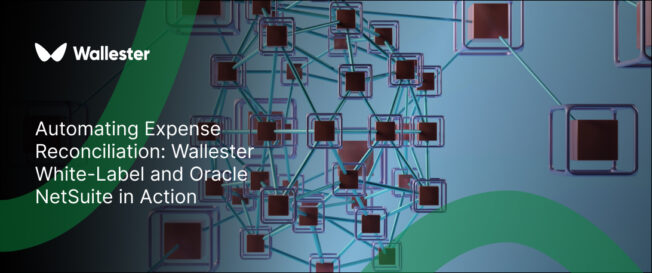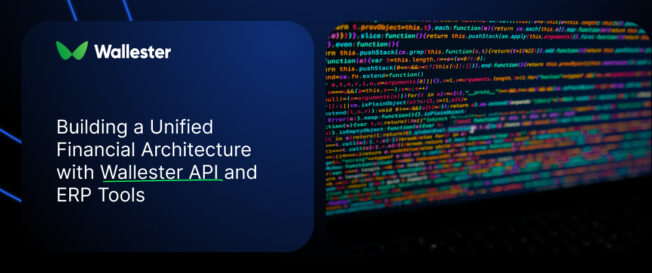Modern finance teams rely on accuracy, speed, and visibility. Yet expense reconciliation still consumes more time than it should. According to a recent report, around 35% of companies still handle expenses manually using spreadsheets or paper-based workflows, which leads to delays and frequent corrections. Data often arrives late, entries are duplicated, and reports need manual correction. Oracle NetSuite gives companies a single environment for accounting and reporting, but it depends on complete, real-time data. Wallester White-Label provides the connection, transferring transaction information from corporate cards directly into NetSuite to make reconciliation fast, automatic, and transparent.
Why expense reconciliation still slows finance
Even advanced ERP setups struggle with expense reconciliation. Payments happen across teams, countries, and currencies, but the accounting view often updates much later. Files are exported, receipts are matched manually, and small delays turn into week-long bottlenecks.
The result is a routine problem that finance leaders know too well.
- Duplicated or missing entries appear in reports.
- Expense submissions pile up close to month end.
- Managers make decisions based on incomplete data.
When transaction data does not flow automatically, closing the books becomes an exercise in guesswork. Reconciling faster means letting systems talk directly to each other rather than relying on spreadsheets.
Further Reading: The Complete Guide to Integrating Wallester White-Label with ERP Systems
The role of Oracle NetSuite in financial operations
Oracle NetSuite is a widely used cloud ERP platform covering accounting, procurement, and reporting. Its Financial Management modules record every transaction in the general ledger, support automated reconciliation, and handle multi-entity operations.
NetSuite is designed for transparency. Every payment, refund, or journal entry becomes part of a single financial dataset. But to work efficiently, it needs accurate information at the moment a transaction happens. When payment systems and cards are disconnected, reconciliation becomes manual, and visibility disappears between updates. Integrating NetSuite with a live card-issuing infrastructure is what closes that gap.
Wallester White-Label: connecting card data to NetSuite
Wallester White-Label is a financial platform that allows enterprises to issue their own branded Visa cards and control spending in real time. It is built on an API-first architecture, giving companies the flexibility to connect card transaction data directly to ERP systems like Oracle NetSuite.
Every payment made through a Wallester card includes structured details such as merchant, amount, time, and category. These data points can be mapped to NetSuite’s accounts, cost centres, or project codes. By combining Wallester’s card infrastructure with NetSuite’s reconciliation tools, enterprises can automate how transactions appear in accounting, without re-entering any data manually.
How the integration works in practice
Integration between Wallester and NetSuite follows a clear and practical process that mirrors how financial data moves through the organisation.
A typical flow includes:
- Transaction creation. A payment is made with a Wallester virtual or physical Visa card and processed in real time through Wallester’s system.
- Secure data transfer. Transaction details such as amount, merchant, and time are sent through encrypted, authenticated API connections.
- Data matching. Within the company’s integration setup, fields are linked to the correct departments, vendors, or projects according to predefined rules.
- Entry creation. NetSuite generates corresponding records for review or posting, depending on how the enterprise has configured its workflow.
- Reporting update. Finance teams see the new data reflected in their dashboards soon after processing, keeping reports current.
This structure keeps accounting and spending consistent. Instead of importing files in bulk, data moves into the ERP steadily, allowing reconciliation to happen throughout the accounting period.
Further Reading: How Wallester White-Label Connects with SAP: From Transactions to Real-Time Reporting
Key benefits for finance teams
Integrating Wallester White-Label with Oracle NetSuite helps finance departments replace repetitive work with real-time control. The practical outcomes are easy to measure.
- Faster reconciliation with fewer manual adjustments
- Accurate and traceable records for every transaction
- Shorter month-end closing periods
- Live visibility of departmental spending and budgets
- Reliable data for audits and compliance reviews
With transactions appearing directly in the ERP, accountants can focus on exceptions instead of processing every single entry. Reporting becomes a reflection of what is happening in the business, not what happened last week.

Security, compliance, and audit transparency
Wallester operates under PCI DSS Level 1 certification, which covers the highest standards of card data protection. It also complies with GDPR requirements for personal and financial information. Data transmitted to NetSuite travels through encrypted, authenticated channels.
Within the ERP, companies manage access and audit trails through existing roles and permissions. This separation of responsibilities keeps financial information secure and traceable. Cardholder data remains protected on Wallester’s side, while only the fields required for accounting are transferred into the ERP. The process supports both compliance and operational control without adding complexity.
Further Reading: Building a Unified Financial Architecture with Wallester API and ERP Tools
Example use cases
Corporate travel
When employees travel on business, their card payments appear in NetSuite automatically, sorted by cost centre or department. Finance teams do not have to collect receipts or re-enter data.
Subscription management
Departments paying for software or recurring services can use dedicated Wallester cards. Each charge is categorised and reconciled automatically, giving full visibility into active subscriptions.
Supplier purchases
Teams using corporate cards for urgent procurement see the expense appear in NetSuite right after authorisation. The transaction can then be approved or posted without waiting for manual uploads.
Each of these examples shows how real-time data exchange simplifies daily finance operations.
Further Reading: From Data to Decisions: Why Finance Teams Sync Wallester White-Label with Microsoft Dynamics
Implementation and support
Integrating Wallester White-Label with Oracle NetSuite follows a clear sequence based on standard ERP connection practices. The aim is to create a secure and consistent data flow without changing the company’s existing accounting structure.
A typical process includes:
- Connection setup. Developers register API credentials through Wallester’s resources and configure encrypted, authenticated links between the two systems.
- Data mapping. Finance and IT teams define how transaction details such as amount, merchant, and category correspond to accounts, cost centres, and approval rules in NetSuite.
- Testing and validation. Sample transactions are processed to confirm that entries post correctly, appear in reports, and maintain data accuracy across both platforms.
- Deployment and monitoring. After verification, the integration moves into active use, and performance is tracked through the company’s standard monitoring tools.
Wallester provides the white-label infrastructure and API documentation needed for integration, and enterprises manage the configuration within their own NetSuite environment. This setup keeps control of security, compliance, and financial processes within the company and keeps transaction data moving accurately between systems.
Reporting and analytics
When transaction data enters NetSuite without delay, reports become more accurate and more useful. Finance teams can monitor spend by department, project, vendor, or merchant category using built-in dashboards and saved searches. Filters surface the activity that matters to each role, so controllers can focus on exceptions while managers track their budgets against live figures. Period views update as entries are posted, which keeps the picture current throughout the month.
This visibility improves forecasting and day-to-day decisions. Budgets can be adjusted on the basis of actual spending rather than estimates, and unusual patterns are easier to spot while context is still fresh. Variance analysis becomes part of the routine workflow instead of a one-off exercise at month end. Reconciliation is no longer a retrospective task but an ongoing activity that keeps accounting up-to-date every day.
Long-term impact for enterprise finance
Automated expense reconciliation changes how finance departments operate. Teams see spending as it happens, approvals move in line with policy, and accounting entries follow a predictable path from transaction to posting. Processes that once needed hours of manual verification are replaced by a steady flow of structured data and clear rules. Month-end turns into confirmation rather than correction.
Over the long term this consistency supports stronger governance and planning. Audit trails stay intact across entities and currencies, which helps with internal control and external review. Leaders get a single view that is stable enough for forecasting and flexible enough for operational checks. When Wallester White-Label and Oracle NetSuite work together, financial data moves from payment to ledger to analysis in one continuous sequence across the organisation.
From manual checks to real-time control
Connecting Wallester White-Label with Oracle NetSuite brings automation to one of the most time-consuming areas of finance. Each transaction becomes part of a verified, traceable data stream that feeds the ERP in real time. Finance teams close books faster, managers monitor spending with clarity, and auditors can follow every record from authorisation to reporting. The outcome is a cleaner process, fewer surprises at month end, and more time for analysis.

If you are ready to simplify expense reconciliation and build a more connected finance workflow, contact Wallester to discuss integration options with your NetSuite environment. Our team will review your setup, outline a practical approach, and help you plan a rollout that fits your organisation.


